
Introduction
On 13th March 2025, final-year History students from the University of Sussex spent a day by the sea visiting the Towner Eastbourne. The day offered students a valuable opportunity to work together and reflect on how the skills and knowledge they’ve developed throughout their course can be applied beyond the University.
The day began at 9am at Brighton train station. At first, things were quiet—everyone was still waking up and gathering their thoughts for the day ahead. But during the 30-minute train ride to Eastbourne, the atmosphere became more relaxed, and conversations started to flow. As the day progressed, energy and engagement grew—highlighting the value of stepping outside traditional teaching spaces.
At the Gallery, students explored the exhibitions and went behind the scenes into the archives, gaining insight into how the organisation operates. The students had a room of their own at the Museum, allowing them to come together, share ideas and reflect on what they had seen. This space was also used for short workshops and talks for the students, introducing them to various aspects of object collection and community engagement.
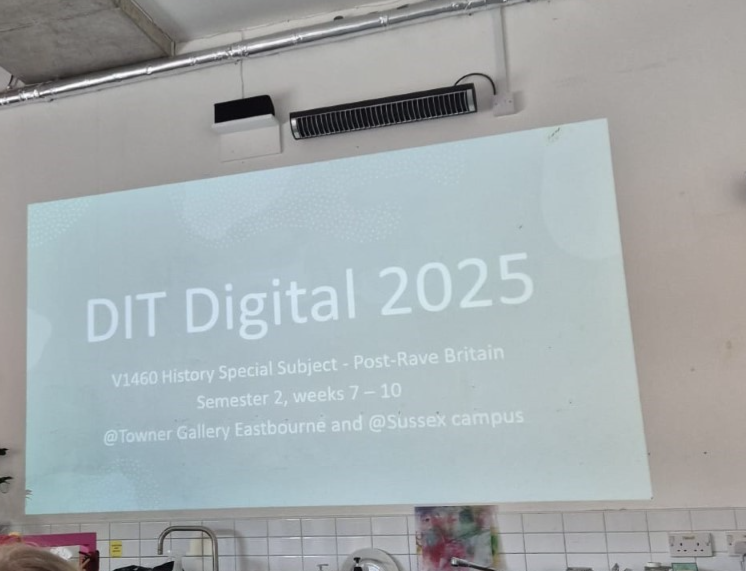
The day was organised by Professor Lucy Robinson and Associate Professor Chris Warne and formed part of a broader effort to help students see how the study of history shapes public life—and how they, as historians, can contribute to that work by bringing their discipline expertise and skills into the wider cultural landscape. The visit was part of Do It Together (DIT) Digital. Lucy explains:
DIT Digital is a really important part of how Chris and I work. It’s part of a wider collaborative research and impact project with the Subcultures Network and the Museum of Youth Culture (MOYC). We want our students to benefit from how universities connect with the wider world beyond the lecture and seminar room. We want to weave teaching into all of our research and public work, providing students with real world experience. In this case for example, DIT Digital will feed into our event that we are organising as part of the Brighton Festival for the University’s Festival of Ideas. Students will be our collaborators in the project, developing an ethics application, designing a collections forms, and working with the public at the events to collect objects for the MOYC’s archive.
Quote from Prof. Lucy Robinson.
In preparation for their work at the festivals, the visit encouraged and trained students to think about how to record, interpret, and present historical objects to people—and how community-facing institutions like Towner play a key role in this process. As its name suggests, Towner is a space designed for the town; a place where art and everyday life intersect.
Capturing and sharing objects digitally
One of the aims of the day was to help students explore how digital tools can be used to document, share, and interpret historical objects. George Robinson and I introduced students to Padlet, which enables students to capture historical material in a variety of formats.
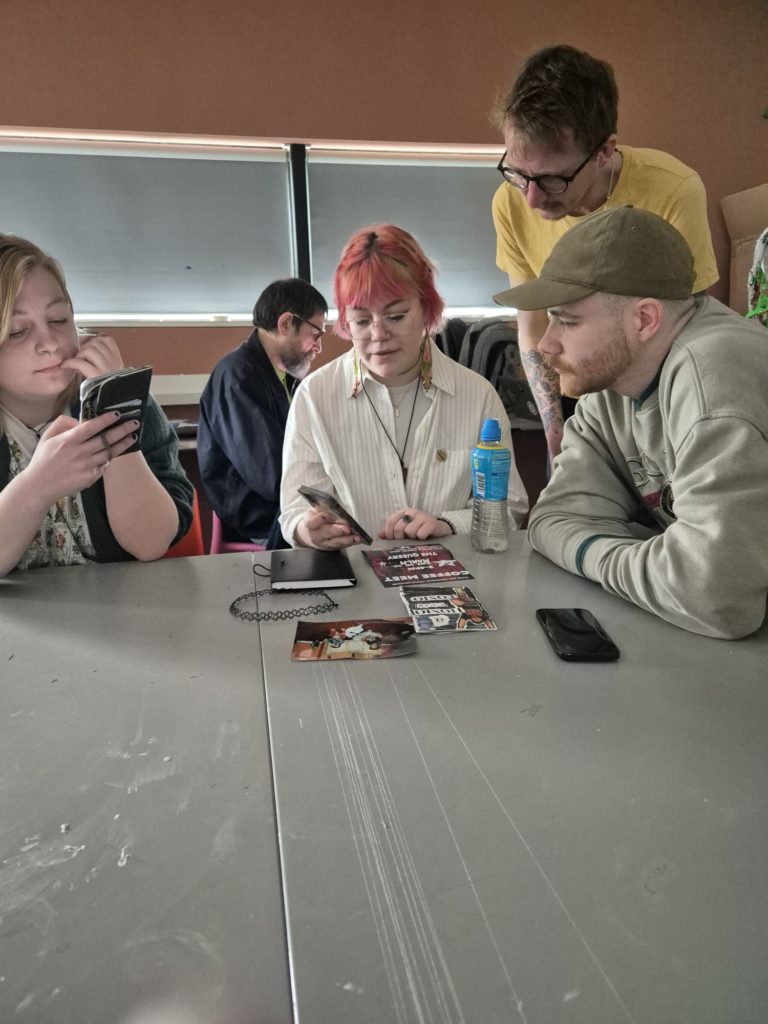
Padlet allows users to record content directly or upload media from their phone or device. Each object entry can be complemented with links to relevant external sources, such as podcasts, journal articles, or YouTube videos—enriching the historical context with multiple perspectives.
Students also explored how to curate their Padlet boards, transforming them into either:
- a deep dive into a single object, layered with media and supporting content.
- a digital museum, echoing the store at Towner, where viewers can explore a diverse collection of objects across time periods and themes.
Importantly, Padlet also allows for community engagement. It can be an open access resource where members of the public can:
- contribute objects, stories, and images
- reflect and comment, creating a dialogue around shared histories
- co-curate collections, encouraging shared ownership of cultural memory
Behind the scenes: The Towner store
A highlight of the visit was a tour of Towner’s art store—a temperature and bug-controlled archive space. The tour was led by Liz Corkhill (Skills and Opportunities Producer at Towner). Part of Liz’s role is to extend the gallery’s collections to the wider community, and she shared her knowledge of the collection, offering fascinating stories about the wide array of objects held by Towner.
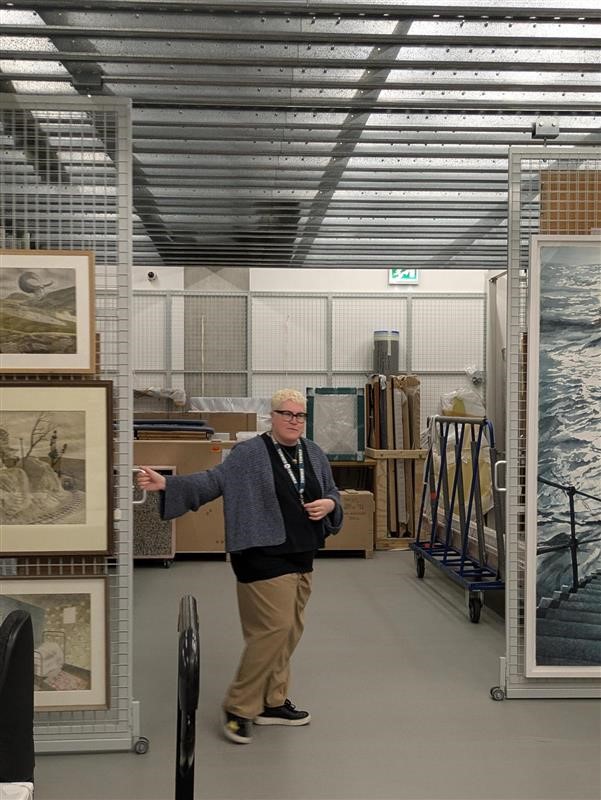
Among other things, students discovered that:
- Only 18% of the works at Towner are by women, and the gallery is actively working to improve representation. (This figure, notably, is still higher than the National Gallery, which currently stands at around 1–3%.)
- The Towner houses the world’s largest collection of works by Eric Ravilious.
- A well-run art store is all about organisation—where objects are carefully categorised, clearly labelled, and correctly stored.
Art, archaeology, and everyday objects: The Findings
It was excellent to hear about The Findings—a public art project by artist Verity-Jane Keefe, exhibited at Towner and across Eastbourne.
The project responded to the recent excavation of a significant Bronze Age settlement at Shinewater and Langney (near Eastbourne). Keefe’s work bridged archaeology, art, and everyday life, exploring what it meant to find, hold, and interpret objects from the past.
Her installation featured large-scale brass sculptures, cast from everyday objects unearthed at the site—soft drink cans, bricks, pre-historic tools—juxtaposing the ancient with the contemporary. Keefe worked with local schools, businesses and organisations to select, preserve and place the found objects in public spaces across Shinewater and Langney, including shopping centres and housing estates, inviting passersby to engage with them.
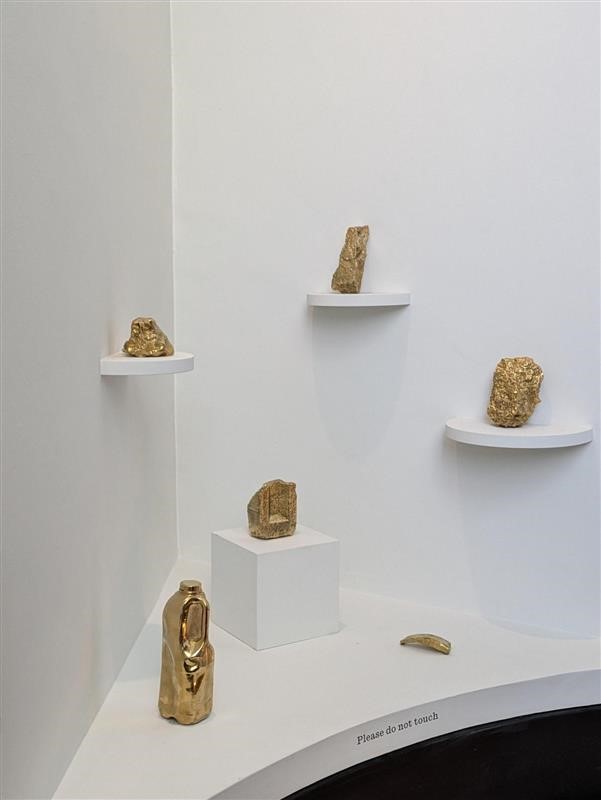
The Findings was a community project, resulting in community-made art. It was a clear demonstration of collective approaches to history, and one that reflected the ethos of both the Towner Gallery and the teaching philosophy of Lucy and Chris.
The Museum of Youth Culture
Also attending the day was Ann O’Toole from the MOYC, which celebrates the lived experiences, creativity, and everyday heritage of young people in Britain.
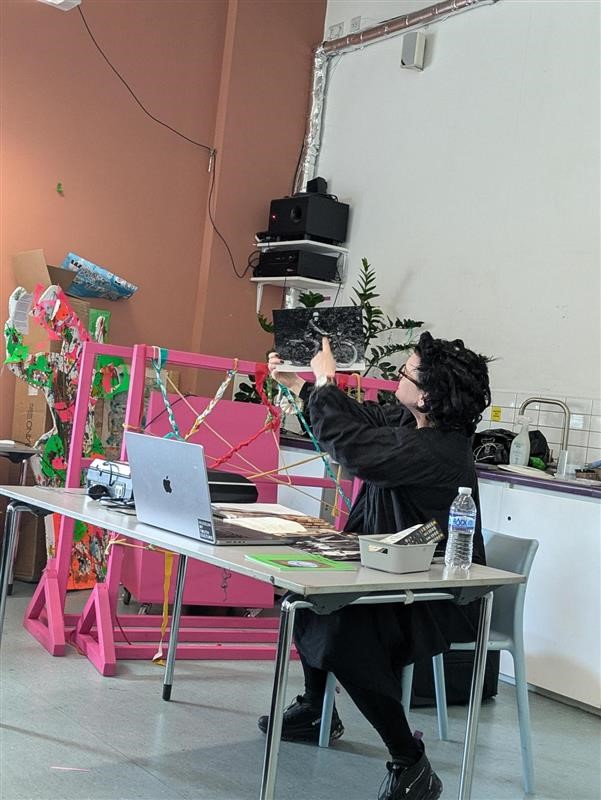
Students were invited to engage with this idea of everyday heritage by bringing in their own objects that spoke to personal or cultural stories of youth. These were items like a parent’s 1980s Psychobilly leather jacket, a photo at a festival that represented notions of collectivism and nostalgia, and an Acid House CD that had been listened to by both the student and their parents at different points in history, heard through different perspectives, experienced in different ways. These objects, just ordinary things, represented cultures, politics and ideologies of the youth in Britain. Having been scanned by Ann, these objects are now part of the MOYC’s digital collection.
As each student scanned their object/s so that they could form part of the MOYC archive, Ann explained the importance of metadata, ensuring that objects are recorded correctly and can therefore be adequately searched for and understood by the public via the database.
Connecting with Ann was a valuable experience for the students, many of whom followed up with her afterwards to explore volunteering opportunities at the MOYC. After engaging with the students and supporting them in recording objects, Ann shared some key advice about working in the industry. She emphasised the importance of building connections, explaining that it’s often the people you know who help you find job opportunities. She encouraged students to take advantage of internships and volunteer roles—even if just for a few hours—as these experiences not only help develop industry skills and knowledge, but also clarify personal interests and preferences. She also noted that some institutions, like the MOYC, even offer payment for volunteer work.
What did students gain?
I’m sure that each student gained something very individual to them. Here are some of the things I observed:
- Insight into how historical knowledge can shape careers in heritage, museums, archives.
- Practical skills in digitisation, curation, and creative presentation.
- A deeper understanding of how community history and public engagement are central to the work of museums and galleries.
On the train home, one student said it had been incredibly helpful to meet people like Ann from MOYC and Liz from the Towner—to hear about their roles and learn how they got into their careers. Another reflected:
It’s great to talk to professionals, get their advice, and see behind the scenes in this kind of work.
Another student commented that the day had boosted their confidence in engaging with cultural spaces and noted that, while it was nice to have this at the end of their degree as a culmination of their hard work, they would have benefited from more opportunities like this throughout their course.
Next Steps
As an Academic Developer, the day inspired me to help strengthen the connections between the University and cultural institutions like the Towner. This experience was really enriching for the students, not only in terms of enhancing employability, but also in supporting student confidence, satisfaction and wellbeing by applying disciplinary knowledge to life beyond the University and seeing the positive impacts in can have on the community.


[…] Do It Together: History, Culture, Community engagement with the Towner Eastbourne […]